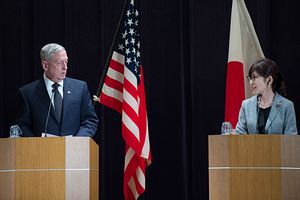On Saturday, U.S. President Donald Trump’s defense secretary, James Mattis, reaffirmed the United States’ commitment to defend Japanese territory from attack.
Mattis specifically mentioned that Article 5 of the U.S.-Japan Treaty of Mutual Cooperation and Security would cover the disputed Senkaku/Diaoyu Islands in the East China Sea, which Japan administers, but China claims.
In a press conference following consultation between Mattis and his Japanese counterpart Tomomi Inada, Mattis offered the affirmation: “I made clear that our long-standing policy on the Senkaku Islands stands — the U.S. will continue to recognize Japanese administration of the islands and as such Article 5 of the U.S.-Japan Security Treaty applies.”
Article 5 of the U.S.-Japan treaty commits the United States to defend aggression against territories under Japanese administration.
With his statement on the Senkaku Islands, Mattis became the highest-level U.S. official to affirm that Article 5 of the U.S.-Japan treaty covered the islands since former U.S. President Barack Obama’s 2014 visit to Japan.
Obama was the first U.S. president to explicitly mention that the alliance extended to the Senkakus: “The policy of the United States is clear—the Senkaku Islands are administered by Japan and therefore fall within the scope of Article 5 of the U.S.-Japan Treaty of Mutual Cooperation and Security. And we oppose any unilateral attempts to undermine Japan’s administration of these islands,” Obama had stated in 2014, in an interview with Japan’s Yomiuri Shimbun.
China, which claims the islands, responded quickly to Mattis’ statement in Japan, which had been anticipated before his trip to Japan, as The Diplomat had noted.
“Diaoyu and its affiliated islands have been Chinese territory since ancient times. These are historical facts that cannot be changed. The so-called U.S.-Japan security treaty was a product of the Cold War, and it should not harm China’s territorial sovereignty and legitimate rights,” Chinese Foreign Ministry spokesman Lu Kang noted at a press conference.
“We urge the U.S. side to adopt a responsible attitude and stop making wrong remarks on the issue of the sovereignty of Diaoyu Islands,” Lu added.
China and Japan experienced a sharp increase in bilateral tensions between 2012 and 2014 in the East China Sea, beginning with Japan’s 2012 decision to nationalize the islands to keep them out of the hands of Shintaro Ishihara, the ultranationalist former governor of Tokyo, and largely ending with the agreement of a “four point consensus” between the two countries in November 2014.
Low-level tensions persisted in the East China Sea through 2015 and early 2016. Beginning in mid-2016, Chinese People’s Liberation Army-Navy vessels and China Coast Guard ships alike increased their activities in the waters around the Senkakus, increasing tensions between Japan and China in the area again.
































